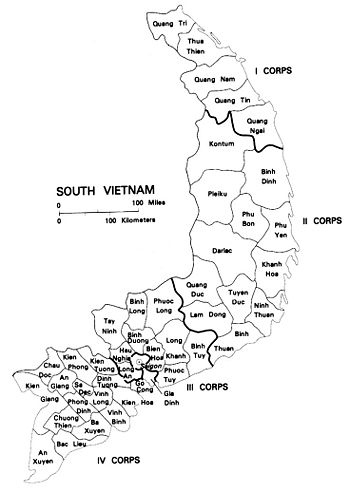I Corps tactical zone
During the Vietnam War, the Army of the Republic of Viet Nam (ARVN) defined I Corps tactical zone (I CTZ)[1] as the five northernmost provinces of South Vietnam: from approximate north to south, these were
Provinces in I CTZ| 1965 name | Capital | Current name |
|---|---|---|
| Quang Tri | Dong Ha | Quang Tri |
| Thua Thien | Hue | Thua Thien-Hue |
| Quang Nam | Tam Ky | Quang Nam |
| Quang Tri | Dong Ha | Quang Tri |
| Quang Ngai | Quang Ngai | Quang Ngai |
Its northern border was the Demilitarized Zone (DMZ) with North Vietnam; National Highway 9 ran along it. On the west, it bordered Laos and areas of the Ho Chi Minh trail.
The largest cities of the zone were Hue and Danang. Major engagements, at small locations, included the Battle of Khe Sanh and the Battle of Con Thien.
North Vietnamese equivalents
These areas came under Military Regions 4 and 5, as well as the B-5 Front.[2]
U.S. equivalents
American forces in I Corps began with III Marine Amphibious Force, its name changed from the usual designation of III Marine Expeditionary Force due to "expeditionary force" having unfortunate connotations, to the Vietnamese, from French usage. Later in the war, the Military Assistance Command, Vietnam, asserted more control over the Marines, variously putting a forward echelon of MACV there, and establishing TASK FORCE OREGON and Provisional Corps, Vietnam.
Commanders
In 1972, Hoang Xuan Lam was dismissed for incompetence.
References
- ↑ Corps is usually a tactical, rather than geographical structure; the U.S. renamed its Vietnam War corps formation s "field forces" to avoid confusion. In July 1970, the Republic of Vietnam redesignated its CTZs as Military Regions (MR). ARVN MR numbers, however, had no relationship to the People's Army of Viet Nam's MR numbering scheme.
- ↑ Pearson, Willard (1975), Vietnam Studies : The War in the Northern Provinces, Office of the Chief of Military History, U.S. Army

